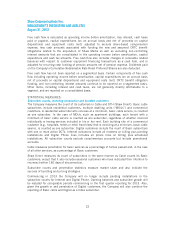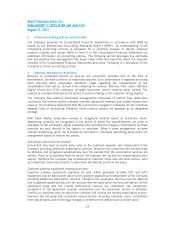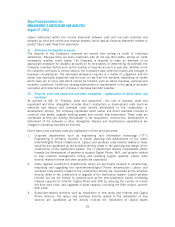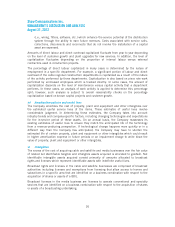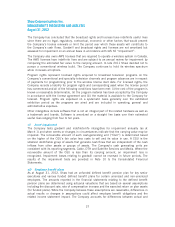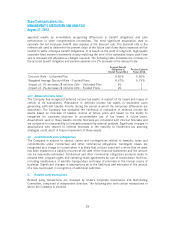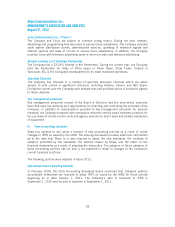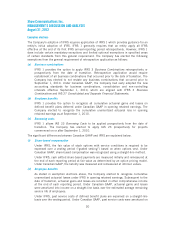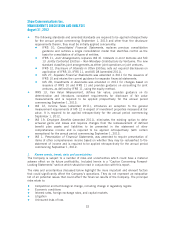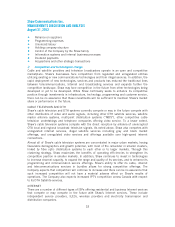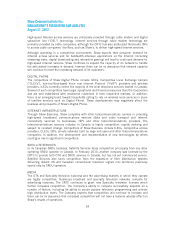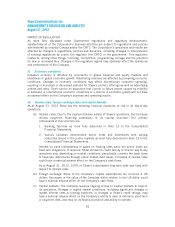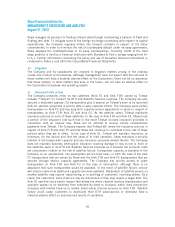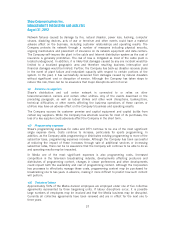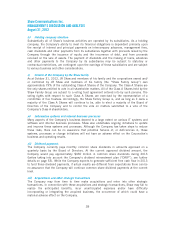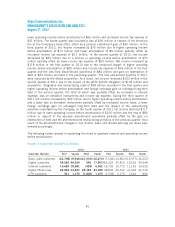Shaw 2012 Annual Report Download - page 34
Download and view the complete annual report
Please find page 34 of the 2012 Shaw annual report below. You can navigate through the pages in the report by either clicking on the pages listed below, or by using the keyword search tool below to find specific information within the annual report.Shaw Communications Inc.
MANAGEMENT’S DISCUSSION AND ANALYSIS
August 31, 2012
Exemption elections
The Company’s adoption of IFRS requires application of IFRS 1 which provides guidance for an
entity’s initial adoption of IFRS. IFRS 1 generally requires that an entity apply all IFRS
effective at the end of its first IFRS annual reporting period retrospectively. However, IFRS 1
does include certain mandatory exceptions and limited optional exemptions in specified areas
of certain standards from this general requirement. The Company has elected the following
exemptions from the general requirement of retrospective application as follows:
(a) Business combinations
IFRS 1 provides the option to apply IFRS 3 Business Combinations retrospectively or
prospectively from the date of transition. Retrospective application would require
restatement of all business combinations that occurred prior to the date of transition. The
Company has elected to not restate any business combinations that occurred prior to
September 1, 2010. Under Canadian GAAP, the Company had early adopted the new
accounting standards for business combinations, consolidation and non-controlling
interests effective September 1, 2010, which are aligned with IFRS 3 Business
Combinations and IAS 27 Consolidated and Separate Financial Statements.
(b) Employee benefits
IFRS 1 provides the option to recognize all cumulative actuarial gains and losses on
defined benefit plans deferred under Canadian GAAP in opening retained earnings. The
Company elected to recognize the cumulative unamortized actuarial loss in opening
retained earnings as at September 1, 2010.
(c) Borrowing costs
IFRS 1 allows IAS 23 Borrowing Costs to be applied prospectively from the date of
transition. The Company has elected to apply IAS 23 prospectively for projects
commenced on or after September 1, 2010.
The significant differences between Canadian GAAP and IFRS are explained below.
(i) Share-based compensation
Under IFRS, the fair value of stock options with service conditions is required to be
expensed over a vesting period (“graded vesting”) based on when options vest. Under
Canadian GAAP, share-based compensation was recognized using a straight-line method.
Under IFRS, cash settled share-based payments are measured initially and remeasured at
the end of each reporting period at fair value as determined by an option pricing model.
Under Canadian GAAP, the liability was measured and remeasured at intrinsic values.
(ii) Employee benefits
As stated in exemption elections above, the Company elected to recognize cumulative
unamortized actuarial losses under IFRS in opening retained earnings. Subsequent to the
date of transition, actuarial gains and losses are recorded in other comprehensive income
at the end of each reporting period. Under Canadian GAAP, actuarial gains and losses
were amortized into income on a straight-line basis over the estimated average remaining
service life of employees.
Under IFRS, past service costs of defined benefit plans are expensed on a straight-line
basis over the vesting period. Under Canadian GAAP, past service costs were amortized on
30




